John McCain remembered in Vietnam as a friend, not an enemy

"With a knife in my hand, I intended to stab him. But the people nearby shouted stop," he recalls.Now, more than half a century after that dramatic first and only encounter with a US Navy pilot, Lua laments Sen. McCain's passing."I am very sad," Lua says of his former enemy's death. "I always wanted to meet him [again] since this was such a milestone in my life."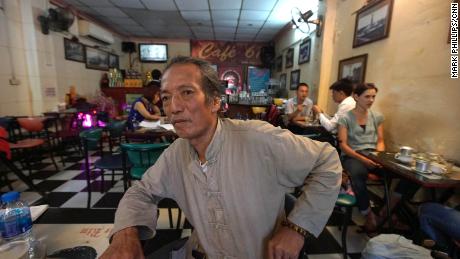 Lua is a rail-thin Vietnamese grandfather with a gray ponytail who makes a living painting calligraphy next to Buddhist temples.The 68-year-old sips sweet coffee in a Hanoi cafe as he recalls the afternoon when he first spotted McCain's parachute.It was October 26, 1967. Lt. Cmdr. John McCain, a US Navy aviator, was piloting a bombing mission targeting a power plant when a surface-to-air missile hit his Douglas A-4 Skyhawk. He ejected from the stricken plane, deep inside enemy territory.That day, Lua, then 17, was a mechanic at a paper factory. He says he was hiding in an air-raid shelter when he caught a glimpse of McCain's parachute."I immediately ran to my kitchen and grabbed a knife," Lua says. "I thought this was an invader who was trying to destroy our power plant and our city as well."
Lua is a rail-thin Vietnamese grandfather with a gray ponytail who makes a living painting calligraphy next to Buddhist temples.The 68-year-old sips sweet coffee in a Hanoi cafe as he recalls the afternoon when he first spotted McCain's parachute.It was October 26, 1967. Lt. Cmdr. John McCain, a US Navy aviator, was piloting a bombing mission targeting a power plant when a surface-to-air missile hit his Douglas A-4 Skyhawk. He ejected from the stricken plane, deep inside enemy territory.That day, Lua, then 17, was a mechanic at a paper factory. He says he was hiding in an air-raid shelter when he caught a glimpse of McCain's parachute."I immediately ran to my kitchen and grabbed a knife," Lua says. "I thought this was an invader who was trying to destroy our power plant and our city as well."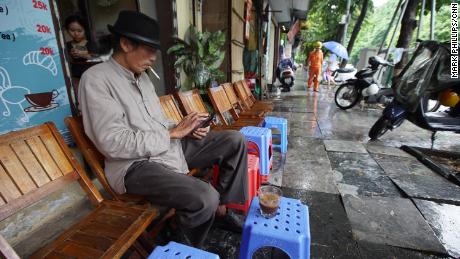 McCain splashed down in Truc Bach Lake, in the heart of Hanoi.Lua says he dove in and swam straight toward the downed pilot."I grabbed his hair immediately," Lua says. "I did not speak English, so I shouted out in French 'haut le mains!'" In other words, "Hands up!"For Lua, the capture of an enemy pilot was one of the proudest achievements of his life. For McCain, it was the beginning of an ordeal as prisoner of war that lasted more than five years.
McCain splashed down in Truc Bach Lake, in the heart of Hanoi.Lua says he dove in and swam straight toward the downed pilot."I grabbed his hair immediately," Lua says. "I did not speak English, so I shouted out in French 'haut le mains!'" In other words, "Hands up!"For Lua, the capture of an enemy pilot was one of the proudest achievements of his life. For McCain, it was the beginning of an ordeal as prisoner of war that lasted more than five years.
Flowers for an enemy
A small monument next to Truc Bach Lake celebrates the downing of McCain's plane. "The citizens and military caught Pilot John Sidney McCain," the statue's engraving says. "This was one of 10 aircraft shot down that same day."But in the days after McCain's death, this monument has been transformed into a makeshift shrine. Admirers have been laying flowers, incense and money at the statue. The US Embassy in Hanoi laid a wreath there."We're not American," says a South African tourist, posing next to the monument for a photo with his wife. "But we respect the man." After his capture, the North Vietnamese authorities brought the badly wounded McCain to Hoa Lo Prison. The former French colonial jail was infamously nicknamed by its American inmates the "Hanoi Hilton."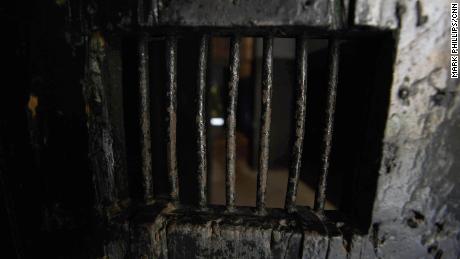 McCain spent much of the next five-and-a-half years in captivity within its thick walls. Today, they block almost all reception from the city's cellphone towers.Nowadays, Hoa Lo Prison is a state museum, frequented by throngs of young tourists dressed in shorts and sandals.During his time in captivity here, McCain and other prisoners of war said, they were repeatedly beaten, left in solitary confinement, forced to sign confessions and denied medical treatment for serious injuries and wounds."I dreaded rope torture more than most other forms of abuse," McCain wrote in his 2005 memoir "Character is Destiny."
McCain spent much of the next five-and-a-half years in captivity within its thick walls. Today, they block almost all reception from the city's cellphone towers.Nowadays, Hoa Lo Prison is a state museum, frequented by throngs of young tourists dressed in shorts and sandals.During his time in captivity here, McCain and other prisoners of war said, they were repeatedly beaten, left in solitary confinement, forced to sign confessions and denied medical treatment for serious injuries and wounds."I dreaded rope torture more than most other forms of abuse," McCain wrote in his 2005 memoir "Character is Destiny."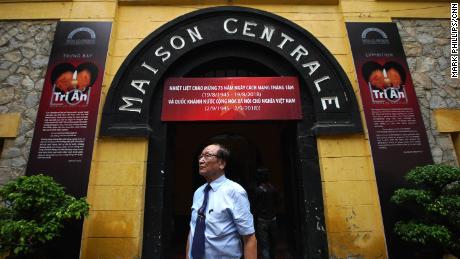 "We were made to sit for hours on a stool a few inches shorter than the chair our interrogator occupied, with our arms behind our back, trussed in ropes wrapped in tight loops around our biceps and cinched around our waist… some prisoners, but not I, were hung by their ropes on hooks in the ceiling of the interrogation room. Others, again not I, were kept for weeks in ankle stocks or leg irons. Often, our interrogators beat the heck out of us."The North Vietnamese offered McCain, whose father was the commander of US forces in the Pacific, an early release from captivity in exchange for a confession. In his 1999 memoir "Faith of my Fathers," McCain explained why he rejected the offer. He argued it would be a breach of the military's code of conduct, and serve as a propaganda victory for the North Vietnamese.
"We were made to sit for hours on a stool a few inches shorter than the chair our interrogator occupied, with our arms behind our back, trussed in ropes wrapped in tight loops around our biceps and cinched around our waist… some prisoners, but not I, were hung by their ropes on hooks in the ceiling of the interrogation room. Others, again not I, were kept for weeks in ankle stocks or leg irons. Often, our interrogators beat the heck out of us."The North Vietnamese offered McCain, whose father was the commander of US forces in the Pacific, an early release from captivity in exchange for a confession. In his 1999 memoir "Faith of my Fathers," McCain explained why he rejected the offer. He argued it would be a breach of the military's code of conduct, and serve as a propaganda victory for the North Vietnamese.
Former jailor
"I first met John McCain in 1967," says Tran Trong Duyet. "He was a tough and strong man. He was loyal to his ideology."From 1968 to 1973, Duyet was the warden of Hoa Lo Prison. Today, the prison museum displays black-and-white photos of Duyet addressing rows of American inmates, shortly before their release in the winter of 1973 as part of the Paris Peace Accords.McCain was among the prisoners sent home then.Now 85 and long since retired, Duyet mourns the death of his former prisoner, a lawmaker whom he credits with helping reestablish diplomatic relations between the US and Vietnam. "If I met him now, I would wish him good health as a good friend always does," he says."Could you please send my deep condolences to his family and his wife. I wish to see his family and his wife in Vietnam," he adds.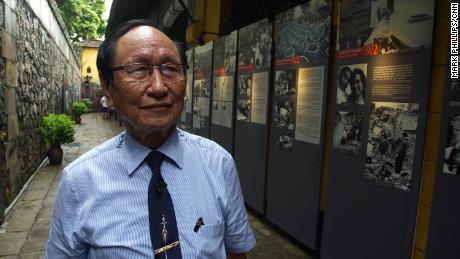 But Duyet denies that McCain and the other POW's were mistreated during captivity. "I think McCain told a lie in his book," he tells me."If we had tortured him, there would not have been the image of McCain coming back to Vietnam so many times and stimulating the Vietnam-US relationship."Daniel Kritenbrik, the US ambassador to Hanoi, says there is no doubt that US prisoners were tortured. "It's absolutely clear and indisputable the torture that many of our veterans suffered," the ambassador says, speaking to CNN in a hallway of the US Embassy, which has been decorated with an American flag, bouquets of flowers and a portrait of McCain.For three days this week, the US Embassy opened its doors to the public, allowing well-wishers to sign a book of condolences.Among the Vietnamese visitors are a 35-year-old accountant named Vu Ngoc Son, who crosses himself and bows before McCain's portrait."Thank you very much Senator John McCain," Son writes in the condolence book. "Please help and continue supporting US and Vietnam — stronger and happier."
But Duyet denies that McCain and the other POW's were mistreated during captivity. "I think McCain told a lie in his book," he tells me."If we had tortured him, there would not have been the image of McCain coming back to Vietnam so many times and stimulating the Vietnam-US relationship."Daniel Kritenbrik, the US ambassador to Hanoi, says there is no doubt that US prisoners were tortured. "It's absolutely clear and indisputable the torture that many of our veterans suffered," the ambassador says, speaking to CNN in a hallway of the US Embassy, which has been decorated with an American flag, bouquets of flowers and a portrait of McCain.For three days this week, the US Embassy opened its doors to the public, allowing well-wishers to sign a book of condolences.Among the Vietnamese visitors are a 35-year-old accountant named Vu Ngoc Son, who crosses himself and bows before McCain's portrait."Thank you very much Senator John McCain," Son writes in the condolence book. "Please help and continue supporting US and Vietnam — stronger and happier."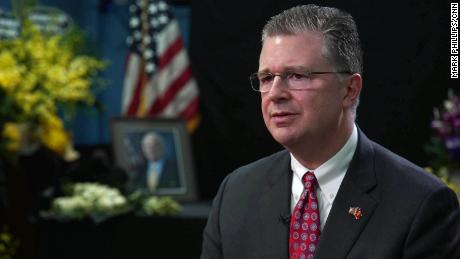 That message was echoed by Pham Quang Vinh, Vietnam's deputy foreign minister and former ambassador to Washington."I came to show the deepest respect for Sen. John McCain — a great man, great statesman and a great friend of Vietnam," Vinh told CNN.In 1995, McCain applauded the Clinton administration's decision to restore diplomatic relations with Vietnam.Kritenbrik argues that as a soldier and then a peacemaker, McCain played a central role in developing the extraordinarily close ties now enjoyed by two former enemy states. "It's close to miraculous to see how far we've come over the last few decades," the ambassador says."To go from the experiences of the war and the experiences of Sen. McCain and what we had here initially, to now be here today where we're talking about a partnership and a friendship."McCain's indelible mark on Vietnam can be seen on the walls of the prison where he once languished. Not far from pictures of him as a wounded POW, there is a photo of a smiling McCain on a tour of the museum in 2000.The senator often stopped in to the "Hanoi Hilton" during more than 20 trips to Vietnam. On one of those visits, the former prisoner left a short message in the museum's guest book. It reads: Best wishes, John McCainUS Senator Arizona
That message was echoed by Pham Quang Vinh, Vietnam's deputy foreign minister and former ambassador to Washington."I came to show the deepest respect for Sen. John McCain — a great man, great statesman and a great friend of Vietnam," Vinh told CNN.In 1995, McCain applauded the Clinton administration's decision to restore diplomatic relations with Vietnam.Kritenbrik argues that as a soldier and then a peacemaker, McCain played a central role in developing the extraordinarily close ties now enjoyed by two former enemy states. "It's close to miraculous to see how far we've come over the last few decades," the ambassador says."To go from the experiences of the war and the experiences of Sen. McCain and what we had here initially, to now be here today where we're talking about a partnership and a friendship."McCain's indelible mark on Vietnam can be seen on the walls of the prison where he once languished. Not far from pictures of him as a wounded POW, there is a photo of a smiling McCain on a tour of the museum in 2000.The senator often stopped in to the "Hanoi Hilton" during more than 20 trips to Vietnam. On one of those visits, the former prisoner left a short message in the museum's guest book. It reads: Best wishes, John McCainUS Senator Arizona
Journalist Trang Nguyen contributed to this report
Original Article
[contf] [contfnew] 
CNN
[contfnewc] [contfnewc]



